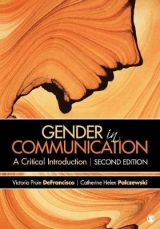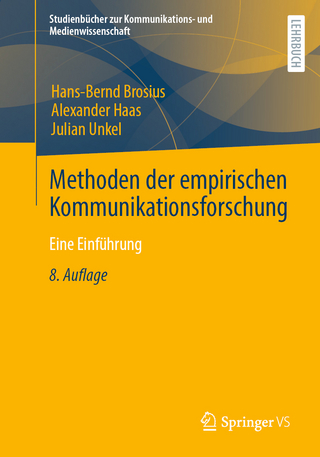
Communicating Gender Diversity
SAGE Publications Inc (Verlag)
978-1-4129-2559-4 (ISBN)
- Titel erscheint in neuer Auflage
- Artikel merken
The purpose behind Communicating Gender Diversity: A Critical Approach is not to provide any final conclusions about communicating gender. Because gender is a constantly evolving concept, both in terms of individuals′ gender identity development and the larger cultureÆs predominant notions of gender, such absolute claims are not possible. Instead, the intent is to better equip readers with tools with which they can examine, and make sense of, the intersections of communication and gender. The text covers the variety of ways in which communication of and about gender and sex enables and constrains people′s intersectional identities. The authors believe people are social actors and, as such, create meaning through their symbolic interactions. Thus, the book′s emphasis is not on how gender influences communication, but on how communication constitutes gender. They also believe that people are capable of being self-reflective about communication processes, and creative in generating new ways to play with symbols.
Victoria Pruin DeFrancisco, PhD, is an emeritus professor in the Communication & Media Department and affiliate faculty in women’s and gender studies at the University of Northern Iowa; studied and taught courses in gender, intercultural, and interpersonal communication; served as director of the Women’s and Gender Studies Program; coordinated the National Coalition Building Institute, a university-wide diversity inclusion program; and has received the following awards: Iowa Regents Award for Faculty Excellence, the UNI Outstanding Graduate Faculty Teaching Award, and the Iowa American Association of University Women Distinguished Faculty Award. Victoria is married and has stepchildren and grandchildren who call her Nana and remind her every day why she wrote this book. Catherine Helen Palczewski, PhD, is a professor in the Communication & Media Department, past director of debate, and affiliate faculty in women’s and gender studies at the University of Northern Iowa; teaches courses in the rhetoric of social protest, argumentation, gender, and political communication; is a past coeditor of Argumentation and Advocacy and director of the 2013 AFA/NCA Biennial Conference on Argumentation held in Alta, Utah; and has received the following awards: the Francine Merritt Award for Outstanding Contributions to the Lives of Women in Communication, the Iowa Regents Award for Faculty Excellence, the University of Northern Iowa College of Humanities and Fine Arts Faculty Excellence Award, the George Ziegelmueller Outstanding Debate Educator Award, the American Forensic Association’s Distinguished Service Award, and two Rohrer Awards for Outstanding Publication in Argumentation.
Part I: Foundations
1. Developing a Critical Gender/Sex Lens
Gender Differences: A Cultural Obsession
A Critical Vocabulary or a New Lens Prescription
Putting It All Together
2. Alternative Approaches to Understanding Gender/Sex
Biological Approaches
Psychological Approaches
Descriptive Cultural Approaches
Critical Cultural Approaches
Conclusion: Gender Diversity
3. Gendered/Sexed Voices
Constructing a Critical Gender/Sex Lens
Constructing Gender/Sex in Communication
Cultural Perceptions of Gender/Sex Styles and Speakers
Power and Talk
Conclusion
4. Gendered/Sexed Bodies
Gender Embodiment: Why Nonverbals Matter
Constructing a Critical Gender/Sex Lens
Components of Nonverbal Communication
Gender as Body Performance
Refusing the Command Performance
Conclusion
5. Gendered/Sexed Language
Theories Explaining the Power of Language
Language Can Be Used to Oppress and Subordinate
Language as Resistance
Conclusion: An Ethics of Language
Part II: Institutions
6. Introduction to Gender in Social Institutions
What Is an Institution?
Institutional Control and Hegemony
Gender Is a Social Institution
Institutionalized Gendered/Sexed Violence
Unit Preview
7. Family
Family as a Social Institution
Interlocking Institutions
Family Constructs (and Constrains) Gender
Emancipatory Families
Conclusion
8. Education
Education as a Social Institution
Interlocking Institutions
It′s Not About Sex Difference
Education Constructs (and Constrains) Gender
Emancipatory Education
Conclusion
9. Work
Work as a Social Institution
Interlocking Institutions
It′s Not About Sex Difference
Work Constructs (and Constrains) Gender
Work as Liberation and Locations of Empowerment in Work
Conclusion
10. Religion
Religion as a Social Institution
Interlocking Institutions
It′s Not About Sex Difference
Religion Constructs (and Constrains) Gender
Religion as Liberation and Locations of Empowerment in Religion
Conclusion
11. Media
Media as a Social Institution
Interlocking Institutions
It′s Not About Sex Difference
Media Construct (and Constrains) Gender
Media as Always Liberatory and Constraining
Conclusion
12. One Last Look Through a Critical Gendered Lens
References
Index
About the Authors
| Erscheint lt. Verlag | 7.8.2007 |
|---|---|
| Verlagsort | Thousand Oaks |
| Sprache | englisch |
| Maße | 177 x 254 mm |
| Gewicht | 590 g |
| Themenwelt | Sozialwissenschaften ► Kommunikation / Medien ► Kommunikationswissenschaft |
| Sozialwissenschaften ► Soziologie ► Gender Studies | |
| ISBN-10 | 1-4129-2559-2 / 1412925592 |
| ISBN-13 | 978-1-4129-2559-4 / 9781412925594 |
| Zustand | Neuware |
| Haben Sie eine Frage zum Produkt? |
aus dem Bereich



